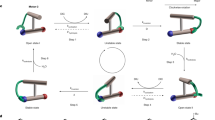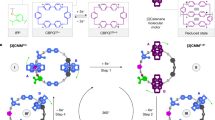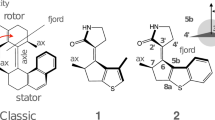Abstract
Biology operates through autonomous chemically fuelled molecular machinery1, including rotary motors such as adenosine triphosphate synthase2 and the bacterial flagellar motor3. Chemists have long sought to create analogous molecular structures with chemically powered, directionally rotating, components4,5,6,7,8,9,10,11,12,13,14,15,16,17. However, synthetic motor molecules capable of autonomous 360° directional rotation about a single bond have proved elusive, with previous designs lacking either autonomous fuelling7,10,12 or directionality6. Here we show that 1-phenylpyrrole 2,2′-dicarboxylic acid18,19 (1a) is a catalysis-driven20,21 motor that can continuously transduce energy from a chemical fuel9,20,21,22,23,24,25,26,27 to induce repetitive 360° directional rotation of the two aromatic rings around the covalent N–C bond that connects them. On treatment of 1a with a carbodiimide21,25,26,27, intramolecular anhydride formation between the rings and the anhydride’s hydrolysis both occur incessantly. Both reactions are kinetically gated28,29,30 causing directional bias. Accordingly, catalysis of carbodiimide hydration by the motor molecule continuously drives net directional rotation around the N–C bond. The directionality is determined by the handedness of both an additive that accelerates anhydride hydrolysis and that of the fuel, and is easily reversed additive31. More than 97% of fuel molecules are consumed through the chemical engine cycle24 with a directional bias of up to 71:29 with a chirality-matched fuel and additive. In other words, the motor makes a ‘mistake’ in direction every three to four turns. The 26-atom motor molecule’s simplicity augurs well for its structural optimization and the development of derivatives that can be interfaced with other components for the performance of work and tasks32,33,34,35,36.
This is a preview of subscription content, access via your institution
Access options
Access Nature and 54 other Nature Portfolio journals
Get Nature+, our best-value online-access subscription
$29.99 / 30 days
cancel any time
Subscribe to this journal
Receive 51 print issues and online access
$199.00 per year
only $3.90 per issue
Buy this article
- Purchase on Springer Link
- Instant access to full article PDF
Prices may be subject to local taxes which are calculated during checkout




Similar content being viewed by others
Data availability
The data that support the findings of this study are available within the paper and its Supplementary Information, or are available from the Mendeley data repository (https://data.mendeley.com/) at http://doi.org/10.17632/2zvst4kg2w.1.
References
Schliwa, M. & Woehlke, G. Molecular motors. Nature 422, 759–765 (2003).
Boyer, P. D. Energy, life, and ATP (Nobel lecture). Angew. Chem. Int. Ed. 37, 2296–2307 (1998).
Santiveri, M. et al. Structure and function of stator units of the bacterial flagellar motor. Cell 183, 244–257 (2020).
Kelly, T. R., Tellitu, I. & Sestelo, J. P. In search of molecular ratchets. Angew. Chem. Int. Ed. Engl. 36, 1866–1868 (1997).
Kelly, T. R., De Silva, H. & Silva, R. A. Unidirectional rotary motion in a molecular system. Nature 401, 150–152 (1999).
Mock, W. L. & Ochwat, K. J. Theory and example of a small-molecule motor. J. Phys. Org. Chem. 16, 175–182 (2003).
Fletcher, S. P., Dumur, F., Pollard, M. M. & Feringa, B. L. A reversible, unidirectional molecular rotary motor driven by chemical energy. Science 310, 80–82 (2005).
Dahl, B. J. & Branchaud, B. P. 180° unidirectional bond rotation in a biaryl lactone artificial molecular motor prototype. Org. Lett. 8, 5841–5844 (2006).
Wilson, M. R. et al. An autonomous chemically fuelled small-molecule motor. Nature 534, 235–240 (2016).
Collins, B. S. L., Kistemaker, J. C. M., Otten, E. & Feringa, B. L. A chemically powered unidirectional rotary molecular motor based on a palladium redox cycle. Nat. Chem. 8, 860–866 (2016).
Erbas-Cakmak, S. et al. Rotary and linear molecular motors driven by pulses of a chemical fuel. Science 358, 340–343 (2017).
Zhang, Y. et al. A chemically driven rotary molecular motor based on reversible lactone formation with perfect unidirectionality. Chem 6, 2420–2429 (2020).
Koumura, N., Zijlstra, R. W. J., van Delden, R. A., Harada, N. & Feringa, B. L. Light-driven monodirectional molecular rotor. Nature 401, 152–155 (1999).
Pooler, D. R. S., Lubbe, A. S., Crespi, S. & Feringa, B. L. Designing light-driven rotary molecular motors. Chem. Sci. 12, 14964–14986 (2021).
Kelly, T. R. et al. Progress toward a rationally designed, chemically powered rotary molecular motor. J. Am. Chem. Soc. 129, 376–386 (2007).
Feynman, R. P., Leighton, R. B. & Sands, M. The Feynman Lectures on Physics Vol. 1, Ch. 46 (Addison-Wesley Publishing Company, 1963).
Davis, A. P. Tilting at windmills? The second law survives. Angew. Chem. Int. Ed. 37, 909–910 (1998).
Fogassy, K. et al. Efficient synthesis and resolution of (±)-1-[2-carboxy-6-(trifluoromethyl)phenyl]pyrrole-2-carboxylic acid. Tetrahedron Asymmetry 11, 4771–4780 (2000).
Faigl, F., Tárkányi, G., Fogassy, K., Tepfenhardt, D. & Thurner, A. Synthesis and stereochemical stability of new atropisomeric 1-(substituted phenyl)pyrrole derivatives. Tetrahedron 64, 1371–1377 (2008).
Amano, S., Fielden, S. D. P. & Leigh, D. A. A catalysis-driven artificial molecular pump. Nature 594, 529–534 (2021).
Borsley, S., Leigh, D. A. & Roberts, B. M. W. A doubly kinetically-gated information ratchet autonomously driven by carbodiimide hydration. J. Am. Chem. Soc. 143, 4414–4420 (2021).
Ragazzon, G. & Prins, L. J. Energy consumption in chemical fuel-driven self-assembly. Nat. Nanotechnol. 13, 882–889 (2018).
Kariyawasam, L. S., Hossain, M. M. & Hartley, C. S. The transient covalent bond in abiotic nonequilibrium systems. Angew. Chem. Int. Ed. 60, 12648–12658 (2021).
Amano, S., Borsley, S., Leigh, D. A. & Sun, Z. Chemical engines: driving systems away from equilibrium through catalyst reaction cycles. Nat. Nanotechnol. 16, 1057–1067 (2021).
Tena-Solsona, M. et al. Non-equilibrium dissipative supramolecular materials with a tunable lifetime. Nat. Commun. 8, 15895 (2017).
Kariyawasam, L. S. & Hartley, C. S. Dissipative assembly of aqueous carboxylic acid anhydrides fueled by carbodiimides. J. Am. Chem. Soc. 139, 11949–11955 (2017).
Bal, S., Das, K., Ahmed, S. & Das, D. Chemically fueled dissipative self-assembly that exploits cooperative catalysis. Angew. Chem. Int. Ed. 58, 244–247 (2019).
Astumian, R. D. Irrelevance of the power stroke for the directionality, stopping force, and optimal efficiency of chemically driven molecular machines. Biophys. J. 108, 291–303 (2015).
Erbas-Cakmak, S., Leigh, D. A., McTernan, C. T. & Nussbaumer, A. L. Artificial molecular machines. Chem. Rev. 115, 10081–10206 (2015).
Astumian, R. D., Mukherjee, S. & Warshel, A. The physics and physical chemistry of molecular machines. ChemPhysChem 17, 1719–1741 (2016).
Dálaigh, C. Ó. & Connon, S. J. Nonenzymatic acylative kinetic resolution of Baylis-Hillman adducts. J. Org. Chem. 72, 7066–7069 (2007).
Li, Q. et al. Macroscopic contraction of a gel induced by the integrated motion of light-driven molecular motors. Nat. Nanotechnol. 10, 161–165 (2015).
García-López, V. et al. Molecular machines open cell membranes. Nature 548, 567–572 (2017).
Feng, L. et al. Active mechanisorption driven by pumping cassettes. Science 374, 1215–1221 (2021).
Thomas, D., et al. Pumping between phases with a pulsed-fuel molecular ratchet. Preprint at https://doi.org/10.33774/chemrxiv-2021-fl7tv (2021).
Zhang, Q. et al. Muscle-like artificial molecular actuators for nanoparticles. Chem 4, 2670–2684 (2018).
Astumian, R. D. & Bier, M. Mechanochemical coupling of the motion of molecular motors to ATP hydrolysis. Biophys. J. 70, 637–653 (1996).
Astumian, R. D. Thermodynamics and kinetics of a Brownian Motor. Science 276, 917–922 (1997).
Serreli, V., Lee, C.-F., Kay, E. R. & Leigh, D. A. A molecular information ratchet. Nature 445, 523–527 (2007).
Alvarez-Pérez, M., Goldup, S. M., Leigh, D. A. & Slawin, A. M. Z. A chemically-driven molecular information ratchet. J. Am. Chem. Soc. 130, 1836–1838 (2008).
Astumian, R. D. Kinetic asymmetry allows macromolecular catalysts to drive an information ratchet. Nat. Commun. 10, 3837 (2019).
Jayalath, I. M., Wang, H., Mantel, G., Kariyawasam, L. S. & Hartley, C. S. Chemically fueled transient geometry changes in diphenic acids. Org. Lett. 22, 7567–7571 (2020).
Jayalath, I. M., Gerken, M. M., Mantel, G. & Hartley, C. S. Substituent effects on transient, carbodiimide-induced geometry changes in diphenic acids. J. Org. Chem. 86, 12024–12033 (2021).
Amano, S. et al. Insights from an information thermodynamics analysis of a synthetic molecular motor. Nat. Chem. (2022) https://doi.org/10.1038/s41557-022-00899-z.
Ma, B. & Nussinov, R. Enzyme dynamics point to stepwise conformational selection in catalysis. Curr. Opin. Chem. Biol. 14, 652–659 (2010).
Kamerlin, S. C. & Warshel, A. At the dawn of the 21st century: is dynamics the missing link for understanding enzyme catalysis? Proteins 78, 1339–1375 (2010).
Krajnik, B. et al. Defocused imaging of UV-driven surface-bound molecular motors. J. Am. Chem. Soc. 139, 7156–7159 (2017).
Roke, D., Wezenberg, S. J. & Feringa, B. L. Molecular rotary motors: unidirectional motion around double bonds. Proc. Natl. Acad. Sci. USA 115, 9423–9431 (2018).
Acknowledgements
We thank the Engineering and Physical Sciences Research Council (EPSRC; grant number EP/P027067/1), the European Research Council (ERC; Advanced Grant number 786630) and the German Research Foundation (DFG; Individual Postdoctoral Fellowship to E.K.) for funding, the University of Manchester’s Department of Chemistry Services for mass spectrometry, I. J. Vitorica-Yrezabal for X-ray crystallography used to assign atropisomer handedness, S. Amano and J. M. Gallagher for useful discussions, and S. Jantzen of Biocinematics for the rotary motor animation. D.A.L. is a Royal Society Research Professor.
Author information
Authors and Affiliations
Contributions
S.B., E.K. and B.M.W.R. designed and carried out the experiments. D.A.L. directed the research. All authors contributed to the analysis of the results and the writing of the manuscript.
Corresponding author
Ethics declarations
Competing interests
The authors declare no competing interests.
Peer review
Peer review information
Nature thanks the anonymous reviewers for their contribution to the peer review of this article. Peer reviewer reports are available.
Additional information
Publisher’s note Springer Nature remains neutral with regard to jurisdictional claims in published maps and institutional affiliations.
Supplementary information
Supplementary Information
Supplementary sections 1–7 and Appendix
Supplementary Video 1
Animation of the design and autonomous chemically fuelled rotation of motor molecule 1a. Credit: Stuart Jantzen, Biocinematics.
Rights and permissions
About this article
Cite this article
Borsley, S., Kreidt, E., Leigh, D.A. et al. Autonomous fuelled directional rotation about a covalent single bond. Nature 604, 80–85 (2022). https://doi.org/10.1038/s41586-022-04450-5
Received:
Accepted:
Published:
Issue Date:
DOI: https://doi.org/10.1038/s41586-022-04450-5
This article is cited by
-
A DNA turbine powered by a transmembrane potential across a nanopore
Nature Nanotechnology (2024)
-
Endergonic synthesis driven by chemical fuelling
Nature Synthesis (2024)
-
Synthesis goes uphill
Nature Synthesis (2024)
-
A catenane that is topologically achiral despite being composed of oriented rings
Nature Chemistry (2023)
-
Ratcheting synthesis
Nature Reviews Chemistry (2023)
Comments
By submitting a comment you agree to abide by our Terms and Community Guidelines. If you find something abusive or that does not comply with our terms or guidelines please flag it as inappropriate.



